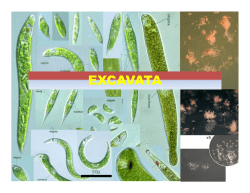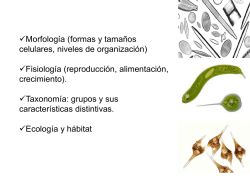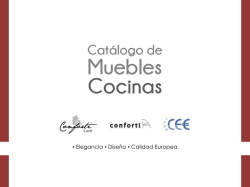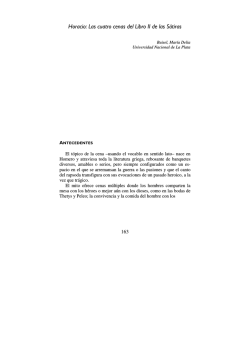
Biología de Fitoflagelados - Sofilac
Curso Postcongreso (40 horas) 13 al 17 de octubre, 2014 Biología de Fitoflagelados Profesores: Dra. Mariângela Menezes, Museo Nacional de la Universidad Federal de Rio de Janeiro, Brasil. Dr. Andrés Boltovskoy, CONICET, Universidad Nacional de La Plata, Provincia de Buenos Aires, Argentina. Dra. Visitación Conforti, Dpto. de Biodiversidad y Biología Experimental de la Facultad de Ciencias Exactas y Naturales de la Universidad de Buenos Aires. Instituto del CONICET IBBEA, Buenos Aires, Argentina. Lugar: Facultad de Ciencias, Circuito exterior S/N, Ciudad Universitaria, UNAM. Fecha y horario: Duración de 5 días (13 al 17 de octubre, 2014), 40 horas totales, con 4 horas de clases teoricas por la mañana (9-13 hs) y cuatro horas de clases prácticas por la tarde (14.30- 16.30). Receso de 1.30 hs para almorzar (13 a 14.30) Justificación del curso: Los fitoflagelados reúnen importantes grupos de microalgas en ambientes de agua dulce en todo el mundo. Particularmente aquellas pertenecientes a las Euglenophyta, Dinophyta, Cryptophyta, así como las clases Synurophyceae, Chrysophyceae y Raphidophyceae (Ochrophyta) se muestran como los grupos más frecuentes en todo tipo de ecosistemas acuáticos continentales y constituyen grupos muy importantes de la biodiversidad de las comunidades del fitoplancton y perifíton. Además, muchas de sus especies forman floraciones que favorecen los desequilibrios ecológicos que, en los casos de los embalses constituyen un serio problema ambiental teniendo en cuenta los múltiplos usos de sus aguas, resultando en costos de tratamiento/remediación del agua elevados. 1 Así, la realización de un curso sobre biología de algas flageladas de aguas dulces es una excelente oportunidad que los alumnos de Biología y Ciencias Ambientales se capaciten y familiaricen con la identificación y la ecología de los principales representantes de algas flageladas de agua dulce de acuerdo con principios metodológicos y conceptuales más modernos. Modalidad de enseñanza: Desarrollo teórico-práctico. El trabajo de laboratorio será dedicado al reconocimiento de los grupos a estudiar: determinación y práctica sobre muestras que se proveerán, así como sobre material aportado por los participantes interesados. Objetivos: - Capacitar a los alumnos en los distintos aspectos de la biología de fitoflagelados, en particular Ochrophyta (Raphidophyceae, Crysophyceae, Synurophyceae), Cryptophyta, Dinophyta y Euglenophyta. - Entrenar en el reconocimiento práctico de los principales entes taxonómicos que los componen. - Analizar los efectos de estas microalgas en los ambientes acuáticos y las condiciones ecológicas en que se desarrollan. - Evaluar sus posibles aplicaciones biotecnológicas. Idioma: Español Contenido General: El curso abarcará el estudio de distintos aspectos de los fitoflagelados: Morfología general y sus distintas variaciones, problemática taxonómicos; ultraestructura, locomoción, reproducción, ecología, evolución, filogenia y aplicaciones biotecnológicas. Especies tóxicas e invasoras y métodos de estudio. Programa: Día 1- 13 de octubre, 2014 CRYPTOPHYTA Posición sistemática de las Cryptophyta. Características generales. Diversidad biológica y ecológica. Taxonomía. Metodología aplicada al estudio taxonómico de Cryptophyta. Día 2- 14 de octubre, 2014 OCRHOPHYTA Características generales. Posición sistemática de las Raphidophyceae, Chrysophyceae y Synurophyceae. RAPHIDOPHYCEAE: Características generales. Diversidad biológica y ecología. Floraciones y toxicidad. Ciclo de vida. Taxonomía. Metodología aplicada al estudio taxonómico de Raphidophyceae. Día 3- 15 de octubre, 2014 CHRYSOPHYCEAE: Características generales. Diversidad biológica y ecología. Ciclo de vida. Taxonomía. 2 Metodología aplicada al estudio taxonómico de Chrysophyceae. SYNUROPHYCEAE: Características generales. Diversidad biológica y ecología. Ciclo de vida. Taxonomía. Metodología aplicada al estudio taxonómico de Synurophyceae. Día 4- 16 de octubre, 2014 DINOPHYTA Dinoflagelados de agua dulce. Características generales. Tecas y quistes de dinoflagelados. Morfología y clasificación. Ciclos de vida. Técnicas de muestreo, microscopia óptica y electrónica de barrido. Floraciones e invasiones Día 5- 17 de octubre, 2014 EUGLENOPHYTA Características generales. Taxonomía. Caracteres esenciales utilizados en su taxonomía. Concepto morfológico y molecular de especie. Principales grupos de euglenófitos. Morfología y ultraestructura. Mitosis. Ecología. Euglenofitos y la contaminación acuática. Evolución. En todas las clases la parte teórica se tratarán los temas enumerados en el programa y en la práctica se identificará material vivo y fijado con ayuda de la bibliografía adecuada. También será posible trabajar con algunos cultivos aportados por los profesores. Requisitos Estudiantes de pre-grado, post-grado y profesionales que actúan en los temas de Biología y Ciencias Ambientales o afines y que posean algún tipo de conocimiento básico en el tema.. Cupo : Máximo 15 (o 20), mínimo 10. Costo: $ 3,800.00 pesos mexicanos (315 USD) Literatura General ADL, S. M., et al. 2012. The revised classification of eukaryotes.J. Euk. Microbiol. 59(5): 429. ANDERSEN, R.A. 2004. Biology and systematics of heterokont and haptophyte algae. Am. J. Bot. 91: 1508–1522. RAPHIDOPHYCEAE, CHRYSOPHYCEAE, SYNUROPHYCEAE (OCHROPHYTA) ANDERSEN, R.A. 2007. Molecular systematics of the Chrysophyceae and Synurophyceae. In: Brodie, J. & J. Lewis (eds): Unravelling the algae: the past, present, and future of algal systematics: 286–310. CRC Press. BOO, S. M., KIM, H. S., SHIN, W., BOO, G. H., CHO, S. M., JO, B. Y.& YOON, H. S. 2010. Complex phylogeographic patterns in the freshwater alga Synura provide new insights into ubiquity vs. endemism in microbial eukaryotes. Mol. Ecol. 19(19), 4328-4338. 3 CRONBERG, G. 1989. Biogeographical studies scaled chrysophytes from the tropics. Nova Hedwigia 95: 191-232. CRONBERG, G. 2005. The life cycle of Gonyostomum semen (Raphidophyceae). Phycologia 44: 285–293. FIGUEROA, R.I. & RENGEFORS, K. 2006. The life cycle and sexuality of the freshwater raphidophyte Gonyostomum semen. J. Phycol. 42:859–871. FINDLAY, D.L., PATERSON, M.J., HENDZEL, L.L. & KLING, H.J. 2005 Factors influencing Gonyostomum semen blooms in a small boreal reservoir lake. Hydrobiologia 533:243–252. HUBER-PESTALOZZI, G. 1941. Das Phytoplankton des Süsswassers: Systematik und Biologie. Chrysophyceen, farblose Flagellaten, Heterokonten. In: Thienemann, A. (ed.): Die Binnengewasser, 16(2). E. Schweizerbart'sche Verlagsbuchandlung, Stuttgart. 365p. JO, B.Y., SHIN, W., KIM, H.S., SIVER, P.A. & ANDERSEN, R.A. 2013. Phylogeny of the genus Mallomonas (Synurophyceae) and descriptions of five new species on the basis of morphological evidence. Phycologia 52(3): 266-278. JORDAN, R.W. & IWATAKI, M. 2012. Chrysophyceae and Synurophyceae. DOI: 10.1002/9780470015902.a0023690. KRISTIANSEN, J. & PREISIG, H.R. 2007. Süsswasserflora von Mitteleuropa, vol 1, part 2, Synurophyceae. Spektrum Akad. Verlag, Heidelberg. KRISTIANSEN, J. & MENEZES, M. 1998. Silica Scaled Chysophytes From An Amazonian Flood Plain Lake, Mussura Lake, Northern Brazil. Algol. Stud. 90:97-118. KRISTIANSEN, J. & VIGNA, M.S. 2002. Chrysophyceae y Synurophyceae de Tierra del Fuego (Argentina). Mon. Mus. Arg. Ciênc. Nat. 3: 1-45. KRISTIANSEN, J. 2001. Biogeography of silica-scaled chrysophytes. Nova Hedwigia 122: 23-39. KRISTIANSEN, J. 2002. The genus Mallomonas (Synurophyceae). A taxonomic survey based on the ultrastructure of silica scales and bristles. Opera Bot. 139: 1–218. KRISTIANSEN, J. 2008. Dispersal and biogeography of silica-scaled chrysophytes. Biod. Cons. 17, 419–426. MENEZES, M. & BICUDO, C.E.M. 2005. Chrysophyceae. In: Bicudo, C.E.M. & Menezes, M. (Org.). Chave de algas de águas continentais do Brasil: chave para identificação e descrições. 2. ed. São Carlos. p. 304-311. MENEZES, M. & HUSZAR, V. L.M. 1997. Bitrichia amazonica, a new species of Stylococcaceae (Chrysophyceae) from Amazonic Region. Algological Stud. 85: 13-22. MENEZES, M. KRISTIANSEN, J. & BICUDO, C.E.M. 2005. Silica-scaled chrysophytes from some tropical freshwater bodies, southeastern Brazil. Nova Hedwigia 128: ŘBZÁČOVÁ, M. & NEUSTUPA, I. 2007. Distribution of the genus Mallomonas (Synurophyceae) ubiquitous dispersal in microorganisms evaluated. Protist 1,58:29-3i. SIVER, P. A. & LOTT, A. M. 2012. Biogeographic patterns in scaled chrysophytes from the east coast of North America. Fresh. Biol. 57: 451–466. ŠKALOUD, P., KYNČLOVÁ. A., BENADA, O., KOFROŇOVÁ, O. & ŠKALOUDOVÁ, M. 2012. Toward a revision of the genus Synura, section Petersenianae (Synurophyceae, Heterokontophyta): morphological characterization of six pseudo-cryptic species. Phycologia 51: 303–329. STARMACH, K. 1985. Chrysophyceae und Haptophyceae. In: Ettl, H., Gerloff, T., Heynig, H. & Mollenhauer, D. (Eds.): Susswasserflora von Mitteleuropa, 1. Gustav Fischer Verlag, Stuttgart. 515p. TAKAHASHI, E. 1978. Electron Microscopical Studies of the Synuraceae in Japan. Taxonomy and Ecology. Tokai University Press, Tokyo, 194pp. CRYPTOPHYTA 4 BRETT, S.J. & WETHERBEE, R. 1986. A comparative study of periplast structure in Cryptomonas cryophila and C. ovata (Cryptophyceae). Protoplasma 131:23-31. BUTCHER, R. W. 1967. An introductory account of the smaller algae of British coastal waters. Part IV: Cryptophyceae. Fishery Investigations, Series IV. Ministry of Agriculture, Fisheries and Food, Her Majesty’s Stationary Office, London, 54 Pp. CHOI, B., SON, M., KIM, J.I.K., SHIN, W. 2013. Taxonomy and phylogeny of the genus Cryptomonas (Cryptophyceae, Cryptophyta) from Korea. Algae 28(4): 307-330. CLAY, B. L., KUGRENS, P. & LEE, R. E. 1999. A revised classification of the Cryptophyta. Bot. J. Linn. Soc. 131:131-151. DEANE, J. A., STRACHAN, I. M., SAUNDERS, G. W., HILL, D. R. A. & MCFADDEN, G. I. 2002. Cryptomonad evolution: nuclear 18S rDNA phylogeny versus cell morphology and pigmentation. J. Phycol. 38:1236-1244. DOMINGOS, P. & MENEZES, M. 1998. Taxonomic Remarks On Planktonic Phytoflagellates In a Hypertrophic Tropical Lagoon (Brazil). Hydrobiologia 369/70: 297-313. HACKETT, J.D., YOON, H.S., LI, S., REYES-PRIETO, A., RUMMELE, S.E. & BHATTACHARYA, D. 2007. Phylogenomic analysis supports the monophyly of cryptophytes and haptophytes and the association of rhizaria with chromalveolates. Mol. Biol. Evol. 24: 1702-1713. HILL, D.R.A. & WETHERBEE, R. 1986. Proteomonas sulcata gen. et sp. nov. (Cryptophyceae), a cryptomonad with two morphologically distinct and alternating forms. Phycologia 25: 521-543. HILL, D.R.A. 1991. A revised circumscription of Cryptomonas (Cryptophyceae) based on examination of Australian strains. Phycologia 30: 170-188. HILL, D.R.A. 1991. Chroomonas and other blue-green cryptomonads. J. Phycol. 27: 133-145. HOEF-EMDEN K, MARIN B, MELKONIAN M (2002). Nuclear and nucleomorph SSU rDNAphylogeny in the Cryptophyta and the evolution of cryptophyte diversity. J. Mol. Evo. 55: 161179. HOEF-EMDEN, K. & MELKONIAN, M. 2003. Revision of the genus Cryptomonas (Cryptophyceae): a combination of molecular phylogeny and morphology provides insights into a long-hidden dimorphism. Protist 154: 371-409. HOEF-EMDEN, K. 2007. Revision of the genus Cryptomonas (Cryptophyceae) II: Incongruences between classical morphospecies and molecular phylogeny in smaller pyrenoid-less cells. Phycologia 46: 402-428. HOEF-EMDEN, K. 2008. Molecular phylogeny of phycocyanin-containing cryptophytes: Evolution of biliproteins and geographical distribution. J. Phycol. 44: 985-993. HOEF-EMDEN, K., MARIN, B., MELKONIAN, M. 2002. Nuclear and nucleomorph SSU rDNA phylogeny in the Cryptophyta and the evolution of cryptophyte diversity. J. Mol. Evol. 55: 161179. HUBER-PESTALOZZI, G. 1950. Das Phytoplankton des Süsswassers: Systematik und Biologie. Cryptophyceen, Chloromonadineen, Peridineen. In: THIENEMANN, A. (Ed.): Die Binnengewässser, 16(3). E. Schweizerbart'sche Verlagsbuchandlung, Stuttgart. 310p. JAVORNICKÝ, P. 2003. Taxonomic notes on some freshwater planktonic Cryptophyceae based on light microscopy. Hydrobiologia 502:271-283. KIM, J. -H., BOO, S. M. & SHIN, W. 2007. Two freshwater cryptomonads new to Korea: Cryptomonas marssonii and C. pyrenoidifera. Algae 22:147-152. KLAVENESS, D. 1988. Ecology of the Cryptomonadida: a First Review. In: Sandgren, C.D. (ed.) Growth and Reproductive Strategies of Freshwater Phytoplankton. Cambridge University Press, Cambridge, pp 105–133. KLAVENESS, D. 1985. Classical and modern criteria for determining species of Cryptophyceae. Bull. Plank. Soc. Jap. 32 (2): 111-123. 5 KUGRENS, P. & CLAY, B.L. 2002. Cryptomonads. In: Wehr, J.D. & Sheath, R.G. (eds.) Freshwater Algae of North America – Ecology and Classification. Academic Press, San Diego, pp 715–755 MARIN, B., KLINGBERG, M., MELKONIAN, M. 1998. Phylogenetic relationships among the Cryptophyta: analyses of nuclear-encoded SSU rRNA sequences support the monophyly of extant plastid-containing lineages. Protist 149: 265-276. MENEZES, M. & BICUDO, C.E.M. 2005. Cryptophyceae. In: BICUDO, C.E.M. & MENEZES, M. (Org.). Chave de algas de águas continentais do Brasil: chave para identificação e descrições. São Carlos. p. 357-382. MENEZES, M. & NOVARINO, G. 2003. How diverse are planktonic cryptomonads in Brazil? Advantages and difficulties of a taxonomic-biogeographical approach. Hydrobiologia, Holanda, 502: 297-306. NOVARINO, G.1991, Observations on Rhinomonas reticulata comb. nov. and Rhinomonas reticulata var. eleniana var. nov. (Cryptophyceae), with comments on the genera Pyrenomonas and Rhodomonas. Nor. J. Bot. 11: 243-252. NOVARINO, G. 1991. Observations on some new and interesting Cryptophyceae. Nor. J. Bot. 11: 599- 611. NOVARINO, G. 2002. Phylum Cryptophyta (Cryptomonads). In: John, D.M., Whitton, B.A. & Brook, A,J. (eds.) The Freshwater Algal Flora of the British Isles an Identification Guide to Freshwater and Terrestrial Algae. pp. 180-185. Cambridge University Press and The Natural History Museum, London. NOVARINO, G. & LUCAS, I. 1993. Some proposals for a new classification system of the Cryptophyceae. J. Linn. Soc. Bot. 111: 3-21. NOVARINO, G., LUCAS, I. & MORRALL, S. 1994. Observations on the genus Plagioselmis (Cryptophyceae). Cryptogamie Algol.15: 87-107. SHALCHIAN-TABRIZI, K., BRÅTE, J., LOGARES, R., KLAVENESS, D., BERNEY, C. & JAKOBSEN, K.S. 2008. Diversification of unicellular eukaryotes: cryptomonad colonizations of marine and fresh waters inferred from revised 18S rRNA phylogeny. Environ. Microbiol. 10: 2635-2644. STARMACH, K. 1974. Cryptophyceae, Dinophyceae, Raphidophyceae. In: Starmach, K. & Sieminska, J. (Eds.): Flora Slodkowodna Polski, 4. Polska Akademia Nauk, Institut Botaniki. Pánstwowe, Wydawnictwo Naukowe, Warzawa. 520p. EUGLENOPHYTA ALVES-DA-SILVA, S.M. & BICUDO, C.E.M. 2006. Contribution to the knowledge of genus Strombomonas (Euglenophyceae) of the state of Rio Grande do Sul, southern Brazil. Algological Studies 119: 29-58. ALVES-DA-SILVA, S.M. & BRIDI, F.C. 2004. Euglenophyta no Parque Estadual do Jacuí, Rio Grande do Sul, Sul do Brasil. 3. Gênero Strombomonas Defl. Acta Botanica Brasilica 18: 555-572. ALVES-DA-SILVA, S.M. & FORTUNA, J.R. 2006. Euglenophyceae de ambientes lênticos na planície costeira do Rio Grande do Sul, sul do Brasil: gêneros Euglena Ehr. e Lepocinclis Perty. Acta Botanica Brasilica 20: 411-422. ALVES-DA-SILVA & VON KURRLE, I.L.P. 2009. O gênero Strombomonas (Euglenophyceae pigmentadas) em ambientes lênticos na Planície Costeira do Rio Grande do Sul, Brasil. Acta Botanica Brasilica 23: 944-955. BALECH, E. (1944): Trachelomonas de la Argentina. - An. Mus. Argent. Cienc. Nat. Bs. As. 41: 221-322. 6 BAUER, D. E., CONFORTI, V., RUIZ, L. Y N. GÓMEZ. 2012. An in situ test to explore the responses of Scenedesmus acutus and Lepocinclis acus as indicators of the changes in water quality in lowland streams. Ecotoxicology and Environmental Safety 77: 71-78. BROSNAN, S., BROWN, P., FARMER, M. & TRIEMER, R. 2005. Morphological separation of the euglenoid genera Trachelomonas and Strombomonas (Euglenophyta) based on lorica development and posterior strip reduction. - J. Phycol. 41: 590-605. CIUGULEA, L., NUDELMAN, M. A., BROSNAN, S. & TRIEMER, R. 2008. Phylogeny of the euglenoid loricate genera Trachelomonas and Strombomonas (Euglenophyta) inferred from nuclear SSU and LSU r DNA. - J. Phycol. 44: 406-418. CIUGULEA, L.& TRIEMER, R. 2010. “A Color Atlas of Photosynthetic Euglenoids”. State Univ. Press, East Lansing. CONFORTI, V. 1993. Study of the Euglenophyta from Camaleão Lake (Manaus - Brazil). I. Trachelomonas EHR. - Rev. Hydrobiol. Trop. 26: 3-18. CONFORTI, V. 1998. Morphological changes of Euglenophyta in response to organic enrichment. Hydrobiol. 369/370:277-85. CONFORTI, V. 1999. Taxonomic and ultrastructural study of Trachelomonas EHR. (Euglenophyta) from suptropical Argentina. - Cryptog. Algol. 20: 167-207. CONFORTI, V. 2009. Floristic and ultrastructural study of the genus Strombomonas (Euglenophyta) from New Jersey fresh waters. E. Schweizerbart´sche Verlag. Stuttgart, Alemania. 0342-1120. Algological Studies 132:1-20. CONFORTI, V. 2010. Ultrastructure of the lorica of Trachelomonas species (Euglenophyta) from New Jersey, U.S.A. E. Schweizerbart´sche Verlag. Stuttgart, Alemania. 0342-1120. Algological Studies 135: 15-40. CONFORTI, V., ALBERGHINA, J. & GONZALEZ URDA, E. 1995. Structural changes and dynamics of the phytoplankton along a highly polluted lowland river of Argentina. J. Aquatic Ecosystem 4:59-75. CONFORTI, V. & PEREZ, M. C. 2000. Euglenophyceae of Negro River, Uruguay, South America. - Algological Studies 97: 59-78. CONFORTI, V., OHIRKO, E. & GOMEZ, N. 2009. Euglenophyta from a stream of Pampean plain subjected to anthropic effects: Aº Rodriguez, Buenos Aires, Argentina. E. Schweizerbart´sche Verlag. Stuttgart, Alemania. 0342-1120. Algological Studies 131:6386. CONFORTI, V. & TELL, G. 1985. Ultraestructura de la lóriga de Trachelomonas EHR. (Euglenophyta) en Microscopio Electrónico de Barrido (MEB).- Nov Hedwigia 43: 45-79. CONFORTI, V., WALNE, P. & DUNLAP, J. 1994. Comparative ultrastructure and elemental compositions of envelopes of Trachelomonas and Strombomonas (Euglenophyta). - Acta Protozool. 33: 71-78. CONRAD, W. & VAN MEEL, L. 1952. Matériaux pour une monographie de Trachelomonas EHR. C. 1934, Strombomonas DEFL., G. 1930 et Euglena EHR. C. 1832, genres d’ Euglénacées. - Mem. Inst. Royal des Sciences Nat. De Belgique. 124: 1-176. COUTÉ, A. & THEREZIEN, Y. 1985. Première contribution à l'étude des Trachelomonas (Algae, Euglenophyta) de l'Amazonie bolivienne. - Rev. Hydrobiol. Trop. 18: 111-131. COUTÉ, A. & THEREZIEN, Y. 1994. Nouvelle contribution a l'étude des Euglenophytes (Algae) de l'Amazonie bolivienne. - Nova Hedwigia 58: 245-272. DA, K. P., MASCARELL, G. & COUTÉ, A. 2009. Etude au microscope électronique à balayage du genre Trachelomonas (Euglenophyta) dans le Sud – Est de la Cote d’Ivoire (Afrique de l’Ouest). - Cryptog. Algol. 30: 31-90. DEFLANDRE, G. 1926. Monographie du genre Trachelomonas EHR. - Nemours, France. 162 p. DILLARD, G. E. 2000. Freshwater algae of South - Eastern United States. Part 7. Pigmented Euglenophyceae. - Bibliotheca Phycol. B. 106: 1-135. 7 GARDUÑO SOLORZANO, G., OLIVA MARTINEZ, M. G., CONFORTI, V., GARCIA GOMEZ, M A, PLIEGO AVEDAÑO, A. y M. ORTEGA GONZALEZ. 2008. “Euglenoideos”. Universidad Nacional Autónoma de Estudios Superiores Iztacala. México. 52 pp. GARDUÑO SOLÓRZANO, G, OLIVA MARTÍNEZ M G, LUGO VÁZQUEZ A, MENDOZA GARFÍAS M B, QUINTANAR ZÚÑIGA R & V. CONFORTI. 2011. Trachelomonas (Euglenophyta) from an eutrophic reservoir in Central México. J. Envir. Biol. 32: 463-71. GOJDICS, M. 1953. The Genus Euglena. The University of Wisconsin Press, Madison, 268 pp. GUALTIERI, P. 2001. Morphology of photoreceptor systems in microalgae. Micron 32: 411-426. HUBER-PESTALOZZI, G. 1955. Das Phytoplankton des Süsswassers. - Teil 4. Euglenophyceen.- Die Binnengewässer. 16:1-606. E.Schweizerbart, Stuttgart, Germany. LEEDALE, G. F. 1975. Envelope formation and structure in the euglenoid genus Trachelomonas. - Br. Phycol. J. 10: 279-294. LEANDER, B. S. & FARMER, M. A. 2000. Comparative morphology of the euglenoid pellicle. I. Patterns of strips and pores. J. Eukaryot. Microbiol. 47:469-79. LEANDER, B. S. & FARMER, M. A. 2001. Comparative morphology of the euglenoid pellicle. II. Diversity of the strip substructure. J. Eukaryot. Microbiol. 48:204-19. LEANDER, B., R. TRIEMER & M. FARMER. 2001. Character evolution in heterotrophic euglenids. Europ. J. Protistol. 37: 337-356. LINTON, E. W., NUDELMAN, M. A., CONFORTI, V. & TRIEMER, R. E. 2000. A molecular analysis of the genus Euglena (Euglenophyta) using SSU rDNA. J. Phycol. 36:740-46. MARIN, B., PALM, A., KLINGBERG, M. & MELKONIAN, M. 2003. Phylogeny and taxonomic revision of plastid - containing Euglenophytes based on SSU rDNA sequence comparisons and synapomorphic signatures in the SSU rRNA secondary structure. Protist 154:99-145. MENEZES, M. (1991): Trachelomonas (Euglenophyceae) no Município do Rio de Janeiro e arrededores, Brasil. - Hoehnea. 18: 171-189. MENEZES, M. & FERNANDES, V.O. 1987. Euglenaceae (Euglenophyceae) pigmentadas do município de Cáceres e arredores, Mato Grosso, Brasil: Uma contribuição a seu conhecimento. Rickia 14: 53-71. NANNAVECCHIA, P., TOLIVIA, A., CONFORTI, V. Ultrastructural alterations in Phacus brachykentron (Euglenophyta) as a result of organic matter excess in the culture medium. Ecotoxicology and Environmental Safety (en prensa). NUDELMAN, M. A., ROSSI, M. S., CONFORTI, V. & TRIEMER, R. E. 2003. Phylogeny of Euglenophyceae based on small subunit rDNA sequences: taxonomic implications. J. Phycol. 39:226-35. NUDELMAN, M., LEONARDI, P., CONFORTI, V., FARMER, M. & TRIEMER, R. Fine structure and taxonomy of Monomorphina aenigmatica comb. nov. (Euglenophyta). 2006. J. of Phycology 42(1): 194-202. NÚÑEZ AVELLANEDA, M., TOLIVIA, A. y V. CONFORTI. 2008. Euglenophyceae: 67-80. En “Microalgas: la otra escala de la biodiversidad en la Amazonia colombiana”. Ed. Instituto Amazónico de Investigaciones Científicas SINCHI, Leticia, Amazonas Colombia. 222 pp. POPOVA, T. G. 1966. Euglenophyta. Part 1. Flora sporovych rastenij SSSR 8. Izd. Nauka, Moskva-Leningrad, 286 pp. [In Russian] POPOVA, T. G. & SAFONOVA, T. A. 1976. Flora plantarum crytogamarum URSS 9. Euglenophyta. 2. Izd. Nauka, Leningrad, 286 pp. [In Russian]. PRINGSHEIM, E. G. 1946. The biphasic or soil-water cultured method for growing algae and flagellates. J. Ecol. 33:193-204. PRINGSHEIM, E. G. 1956. Contributions towards a monograph of the genus Euglena. Nova Acta Leopold. 18:1-168. 8 ROCCHETTA, I, MAZZUCA, M, CONFORTI, V, RUIZ, L, BALZARETTI, V & MC RIOS DE MOLINA. Effect of chromium on the fatty acid composition of two strains of Euglena gracilis. 2006. Envir. Pollution 141:353-358. ROCCHETTA, I, RUIZ, L, MC RIOS DE MOLINA & V CONFORTI. Chromium toxixity to Euglena gracilis strains depending on the physicochemical properties of the culture médium. 2006. Bull. Environ. Contam. Toxicol. 76: 512-521. ROCCHETTA I, LEONARDI P, AMADO FILHO G, RÍOS DE MOLINA MC & V CONFORTI. Ultrastructure and X-ray microanalysis of Euglena gracilis (Euglenophyta) under chromium stress. 2007. Phycologia 46(3): 300-06. ROCCHETTA, I, MAZZUCA, I, CONFORTI, V, BALZARETTI, V, RÍOS DE MOLINA, M C. 2012. Chromium induced stress conditions in heterotrophic and auxotrophic strains of Euglena gracilis. Ecotoxicology and Environmental Safety 84:147-154. ROSOWSKI, J. 2003. Photosynthetic euglenoids, in Freshwater Alagae of North America, Elsevier Science Ed. USA, pp. 383- 422. STARMACH, K. 1983. Euglenophyta-Eugleniny. In: STARMACH, K (ed.): Flora Slodkowodna Polski. 3: 1-593, Polska Akad. Nauk., Warszawa. TELL, G. & CONFORTI, V. 1986. Euglenophyta pigmentadas de la Argentina. - Bibl. Phycol. 75, J. Cramer, Berlin, Stuttgart. 301 pp. TOLIVIA, A., NUÑEZ AVELLANEDA, M., DUQUE, S., CONFORTI, V. 2012. A taxonomic and Ultrastructural Study of naked Euglenophyta from Colombia. Algol. Studies 140: 3-21 WOLOWSKI, K. 1998. Taxonomic and environmental studies on euglenophytes of Kraków – Częstochowa Upland (Southern Poland). - 6: 1-192. WOLOWSKI, K. & HINDÁK, F. 2005. Atlas of Euglenophytes. 136 pp.,VEDA, Bratislava, Slovak Republic. DINOPHYTA ANDERSON, M.; FUKUYO, M & MATSUOKA, K. 2003. Cyst methodologies. In: Manual on harmful marine microalgae, edited by G. M. Hallegraeff, D. M. Anderson, and A. D. Cembella, Paris:IOC of UNESCO, p. 165-189. BALECH, E. 1977. Introducción al fitoplancton marino. EUDEBA, Buenos Aires, x+1-211pp. BOLTOVSKOY, A. 1995. Taxonomía y morfología de los dinoflagelados: Métodos de trabajo. In Manual de métodos ficológicos, edited by Alveal, K., M. E. Ferrario, E. C. Oliveira, & E. Sar (Concepción: Univ. de Concepción). BOLTOVSKOY, A. 1995. Técnicas de microscopía electrónica de barrido: aplicación a las microalgas. In Manual de métodos ficológicos, edited by Alveal, K., M. E. Ferrario, E. C. Oliveira, & E. Sar (Concepción: Univ. de Concepción). CARTY, S. 2003. Dinoflagellates. edited by Wehr, J. D. & R. G. Sheath (New York: Academic Press). EVITT, W.R., 1985. Sporopollenin dinoflagellate cysts: their morphology and interpretation. American Association of Stratigraphic Palynologists, Dallas, U.S.A., 333 p. FENSOME, R.A., TAYLOR, F.J.R., NORRIS, G., SARJEANT, W.A.S., WHARTON, D.I. & WILLIAMS, G.L., 1993. A classification of fossil and living dinoflagellates. Micropaleontology Press Special Paper 7, 351 p. HUBER-PESTALOZZI, G. 1968. Cryptophyceae, Chloromonadophyceae, Dinophyceae. In Die Binnengewässer. XVI. Das Phytoplankton des Süsswassers. Systematik un Biologie, edited by Elster, H. J. & W. Ohle 2 ed. (Stuttgart: Shweizerbart'sche Verlag.). LEFÈVRE, M. 1932. Monographie des espèces d'eau douce du genre Peridinium Ehrb. Archives de Botanique 2, no. 5:1-210+7. POPOVSKÝ, J. & PFIESTER, L. A. 1990. Süsswasserflora von Mitteleuropa. 6. Dinophyceae (Dinoflagellida). Gustav Fischer, Jena, 1-272pp. SCHILLER, J. 1937. Dinoflagellatae (Peridineae). 2. In KLolkwitz, R. (Ed) Rabenhorst's Kryptogamen-Flora von Deutschland, Österreich, und der Schweiz. 10. Flagellatae. 3. Akademische Verlagsgesellschaft, Leipzig, pp. 1-589. STEIDINGER, K. A. & TANGEN, K. 1997. Dinoflagellates. In: Identifiying marine phytoplankton, edited by C. R. Tomas, San Diego:Academic Press, p. 387-584. 9 TAYLOR, F. J. R. (Ed.) 1987. The biology of dinoflagellates (Botanical Monographs, vol. 21). Blackwell, Oxford, xii+1-785pp. 10
© Copyright 2025



